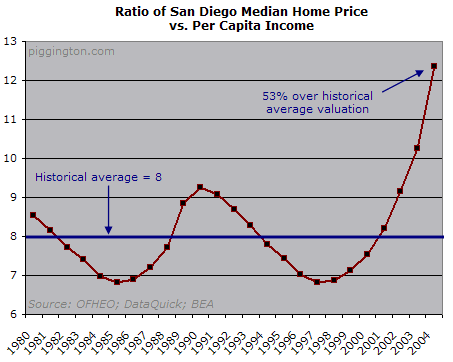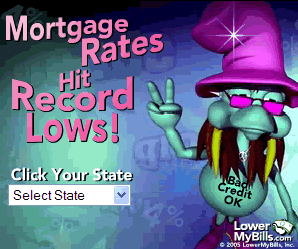I don’t usually spend time discussing media articles of the “there’s no housing bubble” ilk, as I’ve already said my piece in the Bubble Primer series found on the top of the homepage. But there’s an article making the rounds today that has been sent to me enough, and attempts to take a novel enough approach to the argument, that I thought I’d write a little something about it.
The article, found on Yahoo! News with the title “Report: San Diego Housing Bubble a Myth,” describes a study of several regional housing markets (including San Diego) written by some folks at Columbia and U. Penn. Not wanting to get the arguments second-hand, I dutifully searched for the report itself but I couldn’t find anything at the Columbia website, so I will have to make do with the Yahoo! article.
Let’s jump in. The article begins:
With memories of large stock market declines still fresh, many pundits and even some economists observing the large increases in housing prices over the past five years have been quick to declare a bubble.
And we’re off to a good start already. The above statement is entirely false—economists have not been remotely “quick” to declare a bubble. When I started this site in mid-2004, the idea that San Diego was experiencing a bubble was widely considered to be quackery, despite the fact that valuations were way out of line with fundamentals. It was only after the market started cooling off substantially in late 2004 that the mainstream even began to acknowledge the possibility of a housing bubble. At that point, both prices and market psychology had been in bubble territory for years. The vast majority of economists, in other words, were anything but “quick to declare a bubble.”
I admit that the above is a bit of nitpickery that doesn’t really address the central argument. However, it bears noting that we’re only one sentence in and it’s already obvious that the author is not well-versed in the history and popular perceptions of the San Diego housing bubble.
Moving on to describe the report itself, the article states:
The researchers found no evidence that buyers are bidding up the price of houses based on unrealistic expectations of future price increases, the study said.
Hmmm, I guess they didn’t read about the Economist poll wherein the average Los Angeles homebuyer expected an impossibly-high 22% annualized price appreciation for the next decade. They also didn’t appear to read about all the speculators taking negative cash flows on rental properties. Or the ubiquity of negative amortization mortgages that depend on rising home prices to keep the borrowers solvent. They also didn’t appear to talk to anyone who was actually buying a home, the vast majority of whom invariably state their intent to “only live there for a couple of years.” Hell, they didn’t even read their own report, as the article continues:
In cities with higher long-term rates of price appreciation, the annual cost of owning is lower, hence house prices should be higher, relative to rents or incomes, the study said.
In other words, after claiming that prices aren’t being driven up by anticipation of future price gains, they claim that homes in San Diego aren’t actually expensive because owners can expect all those future price gains! Nice. (This, by the way, is the aforementioned “novel argument” that compelled me to write this rant.)
A good litmus test for any home price rationalization is to ask, “was this factor in existence 5 years ago?” If it was, then the rationalization is bogus, because it does nothing to explain why San Diego home prices have doubled over the past five years. The idea that much-higher-than-historical-average home prices are justified by a mild historical upward price trend, in addition to being circular and nonsensical, fails the “5-Year Test” miserably.
Wrapping things up:
The researchers found that recent growth rates of house prices do not reflect a bubble and are in fact largely explained by basic economic fundamentals such as low interest rates, strong income growth among high- income Americans, and unusually low housing prices in the mid-1990s.
Let me just address each of those in turn:
- Low interest rates are categorically not an economic fundamental. This is a topic too complex for this article, but suffice it to say that low rates are by no means guaranteed to stick around, and the lower-than-inflation Fed funds rate that we had from 2002-2004 was a once-in-a-generation stimulus effort that is even now being removed. Moreover, low rates have only offset a small portion of the price increases—for the past five years or so, monthly payments on the median San Diego home have increased 80% despite a relentless decline in rates.
- Income growth in San Diego has come nowhere near to keeping pace with the rise in home prices or, for that matter, monthly payments at the authors’ beloved low interest rates.
- I agree that San Diego home prices were undervalued in the mid-90s; however, the move from “undervalued” to “fairly valued” accounted for a very small portion of the price gains since that time.
Forgive me while I trot an old chart in order to emphasize points 2 and 3:

Regarding point #2, the graph makes it clear that home prices grew quite a bit faster than incomes over the past several years. And as for point #3, San Diego prices were already above their average historical valuation by 2001.
Overall, the arguments put forth in this report (at least as stated in the news article) represent the usual misinformation and poor analysis with a new variety of tortured logic thrown in for good measure. I guess I’m just not that impressed.
Ironically, this ad appeared on the yahoo.com page as I read the article:

I’m not sure what I’m more confused about: why the Grinch is attending a Phish concert, or why somebody thought that would make me want to take out a mortgage.
After laughing derisively at the Hippie Grinch ad, I refreshed the page 5 or 6 times (just in the name of science) and every time I got a new ad for a different subprime mortgage lender. Good thing there’s no housing bubble.
